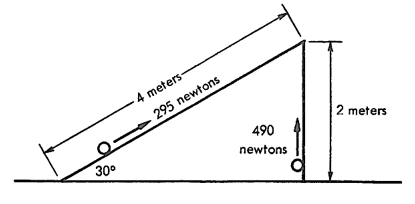LEARNING OBJECTIVE 3.2.A - Describe the work done on an object or system by a given force or collection of forces.
In the last section, we look at a new physical quantity called work. We will now go a bit deeper to get the essence of it.
Before, we start studying the Work in more detail and mathematically. Let’s try to understand why the work is an important physical quantity.
Let us say we wish to raise a 50-kilogram box through a height of two meters onto the back of a truck. Since a kilogram of weight exerts a downward force of 9.8 newtons, a total upward force of 490 newtons is required to lift the box. To exert 490 newtons of force through a distance of two meters in the direction of the force is to do 980 joules of work ( $kg-m^2/sec^2$ is called Joules in SI unit).

Suppose instead that we use an inclined plane, which makes an angle of $30^{\circ}$ with the ground. Under those conditions, the length of the plane from ground to truck is just twice the vertical height from ground to truck, or four meters. The force required to take the box up the plank is 295 newtons, just half the force required for direct lifting. That half-force is exerted through double-distance, however, and 980 joules of work is still done.
The gentler the slope of the inclined plane, the smaller the force required to move the box and the longer the distance through which it must be moved. The inclined plane dilutes the force required. Neither the inclined plane, nor the lever, nor any machine, dilutes work. If we stick to work, rather than force, we never get something for nothing.
But if we gain nothing from work, why bother? The answer is that even if we gain nothing directly, we may gain by altering the distribution between force and distance. If it is a question of lifting, by our unaided effort, if we wish to lift 250 kilograms by two meters directly upward, we must give up. We cannot lift it a meter, a centimetre, or anything at all; we cannot budge it. To move the equivalent of 50 kilograms through ten meters is possible, however, especially if we work slowly; in this way, we can do the same work (50 X 10) that would have been impossible under the previous conditions (250 X 2). To lift the equivalent of five kilograms through 100 meters may be tedious, but it is quite easy.Let’s now look at how to calculate work done by a force.

[…] In the next section, we will look at the essence of work. […]